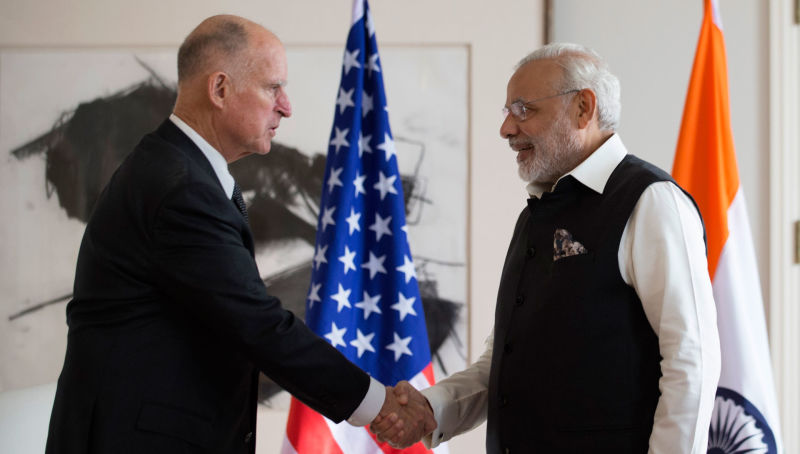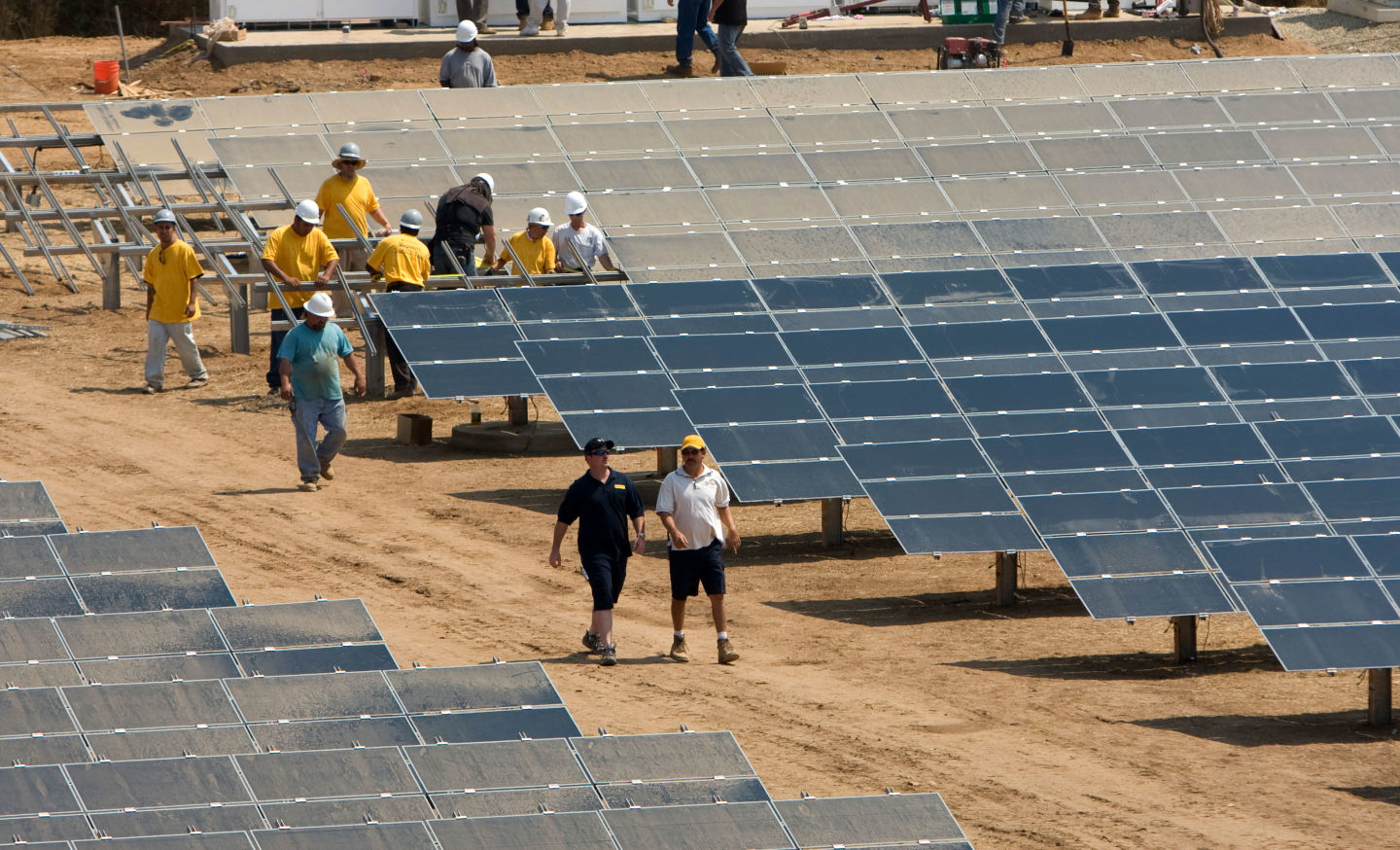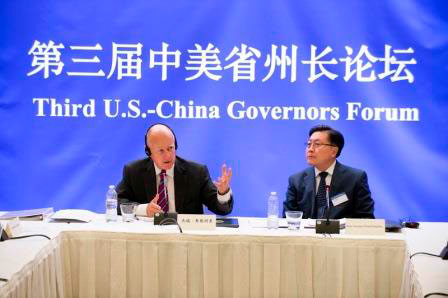Listen to the story:
Governor Brown Takes Climate Message to World Stage

Governor Brown Takes Climate Message to World Stage
World leaders have vowed to go forward with a summit in Paris in two weeks, where they’ll be hashing out a much-anticipated agreement to combat climate change. And among the heads of state and dignitaries, you’ll also see California’s Governor Jerry Brown.
Brown will be making the case that what California does matters to the rest of world.
He’s been spearheading a separate international agreement to cut emissions – not with other countries, but among regional governments like states and provinces.
It’s the product of an international diplomatic tour Brown’s been on for the past year. He visited the United Nations, the Vatican and met with officials from China, India, Canada and Europe, to garner support for the deal.
“The world faces an existential threat,” he told Canadian leaders in July. “I believe the real source of climate change action comes from states and provinces.”
The reason Brown feels compelled to lead the charge? “Troglodytes.”
That’s what the Governor has been calling climate change doubters. And when I caught up with him in an interview recently, he was clear about who he’s pointing the finger at.
“The Republican Congress and all the Republican candidates are in a very deep state of denial despite the vast, vast overwhelming scientific consensus,” he said.
Brown says that while a political stalemate in Washington D.C. is leaving a void, California is there to lead the way.
“Sea level rise, extreme weather events, drought – there’s real catastrophe on the way,” he said. “Somebody has to wake up the country to the real danger.”
Cooperating Across Borders
On Monday, Brown announced that with the latest additions to the Under 2 MOU agreement that he co-founded, the total economies of “subnationals” signed on now exceed the GDP of the entire United States. Parties commit to either reduce greenhouse gas emissions 80 to 95 percent below 1990 levels by 2050 or achieve a per capita annual emission target of less than 2 metric tons by 2050. The name is a reference to the two degrees (Celsius) of warming that scientists say, if the world sticks to, would avoid the most serious impacts.
The regional governments have agreed to cut their emissions 80 percent or more by 2050. “That’s more than the nation-states,” Brown said. “They are far modest in their commitments.”
It’s not a binding promise to cut emissions, but the regions have agreed to cooperate on policy and technology ideas.
Whether the agreement sticks over the years remains to be seen. But Brown argues, when you add up all the signatories, they make up what would be the second largest economy in the world.

It’s a show of support that he thinks will galvanize momentum in Paris.
“We have to light the fire, if I can use that metaphor, putting as much pressure and support behind this global commitment,” he said. “As we know in Silicon Valley or Hollywood, California does set trends.”
“Governor Brown does feel that it is probably the most significant issue of our generation,” said Matt Rodriquez, California’s Secretary for Environmental Protection.
“I can tell you, I sometimes wish we did have a diplomatic core or a state department here,” he added.
Going it alone is something California is known for. Almost a decade ago, the state took on a landmark climate change goal under the state law AB 32, requiring a cut in emissions of about 30 percent by 2020.
The number of policies under the law makes it the most ambitious in the country. Experts say to reach the state’s eventual goal of cutting emission 80 percent under 1990 levels by 2050, the state’s entire economy will be remade.
Record amounts of renewable energy are coming online to meet California’s renewable energy goals. Manufacturers and electric utilities are cutting their emissions, under a cap-and-trade system.
Fuels that power cars and trucks are getting cleaner under the state’s low carbon fuel standard. And automakers are required to offer hundreds of thousands of clean cars for sale on the California market.
Facing the Critics
Today, California has more electric vehicles than any other state.
“I gotta tell you, I love the car,” said Jeff Stone, parking his all-electric Nissan Leaf at his office in Murrieta, California.
Stone is what you’d call an early adopter. This is his third electric car.
“I had a Tesla that I loved,” he said. “And then I had a Coda, one of the first electric cars on the market.”

Stone is also a Republican state senator representing Riverside County and one of the climate skeptics Brown has been pointing a finger at.
Stone is not a fan of California’s go-it-alone approach.
“We represent about one percent or less of any contribution to global warming that happens, if it’s truly man-caused,” he said. “We can’t do it alone.”
He argues California’s many climate rules lead to higher energy costs and give the state a reputation for being un-friendly to business.
“I think you have business people who are throwing up their arms and they’re vacating the state,” Stone said.
It was a common refrain when the state legislature debated SB 350 this summer, a bill designed to raise the bar on California’s climate goals.
Under the law, the state will have to reach 50 percent renewable energy and improve building efficiency by 50 percent, both by 2030. But a provision to cut California’s petroleum use by 50 percent failed, spurred by oil industry-funded ads warning of job losses.
Thought Leader
Still, the Governor has answered back with a political trump card. While the state’s climate change policies have raised both gas and electricity prices by a few percent, they haven’t fulfilled predictions of economic ruin.
“None of them came true,” said Dan Kammen, a professor of energy at UC Berkeley.
“In fact, California’s economy grew faster than the national average,” he said. “So we benefited to some extent by having these environmental laws.”
Kammen argues that setting that example is California’s real contribution to climate change.
“California’s the seventh biggest economy in the world,” he said. “It makes a big difference and it’s a big thought leader.”
The state acts as a testing ground for environmental policies, he says. Many of today’s national environmental standards, including building efficiency, appliance standards and car tailpipe emissions, were based on rules that California passed first.
“Getting a lead actor like California really helps the federal government see what the options are, see what the hurdles are likely to be,” Kammen said.
That trendsetting goes overseas, he says. Some of the Chinese provinces that are piloting cap-and-trade systems worked with California officials to design them.
Which means at the international climate talks, and Kammen has been to 11 of them, California comes up a lot. “We talk about California all the time,” he says.
Something he expects to continue, as California’s Governor heads off to Paris, hoping to make his mark on international discussions to slow the Earth’s steady warming.
